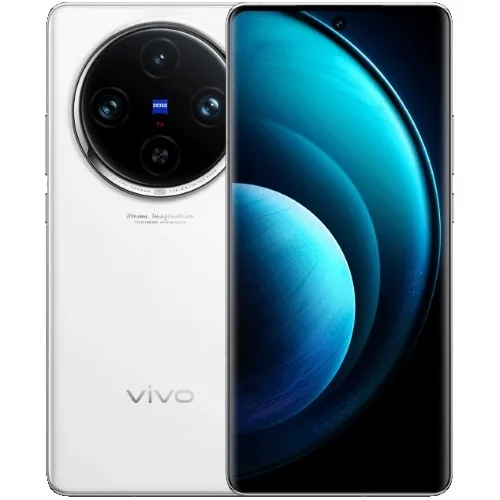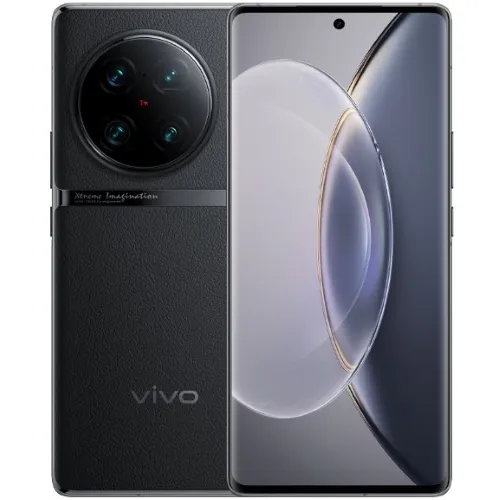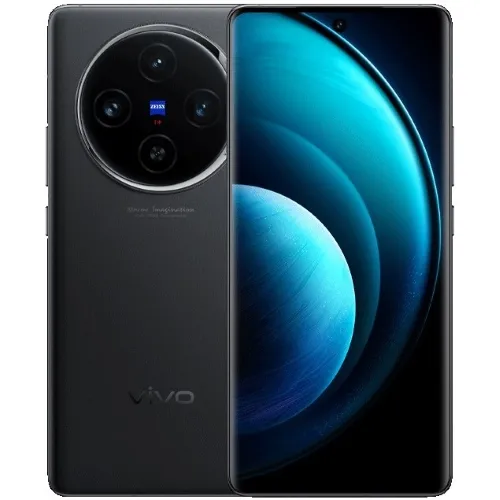10 Best Vivo Mobile Phones in 2025
Vivo is a brand that's currently gaining a lot of attention. They offer interesting smartphones at various price points. For example, in the mid-range category, they have the V series and Y series, while the X series represents their top-end models.
All of these phones come with strong features across the board, making them great options to consider. If you're thinking about getting one, we have put together a list of the best Vivo phones worldwide and highlighted their advantages to help you choose the right one.
1. vivo X200 Pro

vivo X200 Pro delivers powerful performance with the Dimensity 9400 chipset. It comes with 16GB of RAM and 512GB of internal storage, which can ensure smooth multitasking and plenty of space for apps, photos, and videos.
The phone is also IP68/IP69 certified, making it dust and water-resistant. It can survive submersion up to 1.5 meters for 30 minutes without any issues.
Its design stands out with a premium look. The large circular camera module in the center of the back gives it a luxurious feel, similar to a high-end watch.
The phone features a 6.78-inch LTPO AMOLED display with a 1260 x 2800 resolution, which provides sharp visuals and vibrant colors. With a peak brightness of 4500 nits, the screen remains visible even under direct sunlight. It is also protected against scratches and impacts.
The 120Hz refresh rate makes scrolling and gaming feel smooth. Audio quality is just as impressive, thanks to stereo speakers with Hi-Res audio support.
For photography, the vivo X200 Pro includes a triple rear camera system, developed in collaboration with ZEISS Optics. The 50MP main camera (f/1.6) with PDAF and OIS captures sharp and detailed images.
The 50MP ultrawide lens (f/2.0) with autofocus expands the field of view, while the 200MP periscope telephoto lens (f/2.7) offers 3.7x optical zoom, multi-directional PDAF, OIS, and macro capabilities.
The phone also delivers excellent video recording. The rear camera supports 8K resolution at 30 FPS and includes gyro-EIS, 10-bit Log, and Dolby Vision HDR for better stability and color depth.
On the front, the 32MP selfie camera (f/2.0) records in 4K at 60FPS, making it ideal for high-quality video calls and content creation.
Connectivity supports WiFi 7, NFC, infrared, gyro sensors, a color spectrum sensor, and satellite connectivity. The USB Type-C 3.2 port allows Display Out, so you can connect the phone to a larger monitor for an extended screen experience.
Battery life is another highlight. The 6000mAh battery features Silicon Carbide technology, which improves efficiency and longevity. Charging is fast with 90W wired charging, while 30W wireless charging provides a convenient alternative. The device also supports reverse charging, allowing it to share power with other gadgets.
Despite all these advantages, the phone has a few downsides. Video stabilization is not the best, especially when using the front camera.
The smooth body may feel slippery, which might be uncomfortable for some users. The software experience could also be better since it includes ads and pre-installed apps (bloatware) that require extra effort to manage.
2. vivo X100 Ultra

vivo X100 Ultra has an elegant and premium body design, with an IP68/IP69 rating for dust and water resistance. Its LTPO AMOLED display offers impressive brightness levels that reach up to 3000 nits. Powered by the Snapdragon 8 Gen 3 SoC, this phone delivers fast and stable performance.
The rear camera setup is fully equipped, including Zeiss coating to reduce flares, while the front camera features autofocus and supports 4K video recording at 60 fps. In terms of connectivity, the phone includes an infrared blaster and USB display out. It also uses an ultrasonic fingerprint sensor for better responsiveness.
The battery, made from silicon carbide material, provides higher energy density and is supported by 80-watt fast charging and 30-watt wireless fast charging.
Additionally, the phone includes satellite messaging and emergency call features, and it comes with a case and charger in the sales package.
However, the phone's body is quite thick (9.2 mm) and heavy (229 grams). While it has many high-end features, there are no groundbreaking innovations that set it apart from other flagship smartphones.
3. vivo X Fold3 Pro

vivo X Fold3 Pro stands out as the thinnest foldable phone ever made by vivo, with a slim profile of just 5.2 mm. It features a lightweight and sturdy carbon fiber hinge, designed to last up to 12 years.
The phone is also water-resistant up to 1.5 meters for 30 minutes, thanks to its IPX8 rating. Both the main and cover screens are AMOLED and can reach an impressive brightness of up to 4500 nits.
The rear camera setup benefits from Zeiss technology to ensure high-quality photos. Powered by the Snapdragon 8 Gen 3 SoC, the phone delivers snappy everyday performance.
It also features stereo speakers with excellent sound quality and full connectivity, including an infrared blaster and display out via USB 3.2.
The battery is supported by silicon carbide material. Additionally, the phone supports 100-watt fast charging and 50-watt wireless fast charging.
Its multitasking capabilities have been optimized for foldable phones, and it includes various AI features to enhance productivity. The sales package conveniently includes a case and charger.
On the downside, the phone would benefit from including a stylus in the package. The portrait photo results can sometimes feel oversharpened, and there is potential for throttling during heavy workloads.
4. vivo X200

vivo X200 delivers powerful performance with the Dimensity 9400 chipset, paired with 12 GB of RAM and 256 GB of internal storage. It is built to withstand tough conditions, featuring IP68/IP69 certification, making it resistant to dust and water immersion up to 1.5 meters for 30 minutes.
Its design exudes a premium feel, highlighted by a large circular camera module at the center, resembling the elegance of a luxury watch.
The phone has a spacious 6.67-inch AMOLED display with a resolution of 1260 x 2800 pixels. With a peak brightness of 4500 nits, it remains highly visible even under direct sunlight, making it ideal for outdoor use.
Navigating the interface feels smooth and responsive, thanks to the 120 Hz refresh rate, which enhances scrolling and gaming experiences. The stereo speakers deliver high-quality sound with impressive loudness and clarity, adding to the device’s multimedia appeal.
For photography enthusiasts, this phone comes equipped with a triple-camera setup developed in collaboration with ZEISS Optics. The primary camera features a 50 MP (f/1.6) sensor with PDAF and OIS, while the ultrawide lens also offers 50 MP (f/2.0) resolution and includes autofocus.
Additionally, there is a 50 MP (f/2.6) periscope telephoto camera with a 70mm focal length, supporting PDAF, OIS, and 3x optical zoom for detailed close-up shots.
Video recording capabilities reach up to 4K at 60 FPS. However, only the rear cameras come with HDR and gyro-EIS for enhanced stability. Connectivity options are extensive, including WiFi 7, NFC, infrared, and a hardware-based gyroscope.
Battery life is another strong point, featuring a large 5800 mAh capacity. The phone incorporates Silicon Carbide technology for improved efficiency and supports 90W fast charging along with reverse charging capabilities.
Despite its high-end features, the vivo X200 is limited to a USB Type-C 2.0 port, which means it does not support display output. Additionally, the absence of a 3.5mm headphone jack may be inconvenient for users who prefer wired audio.
Another downside is the lack of wireless charging, a feature expected in premium smartphones. For users in some regions, storage options are restricted to 256 GB, as there is no microSD slot for expansion. Offering a 512 GB variant would have been a better choice, especially considering its launch price.
5. vivo X100s Pro

vivo X100s Pro has a sturdy body with an aluminum frame and glass back cover, and it comes with IP68/IP69 dust and water resistance.
It runs on the high-end MediaTek Dimensity 9300+ SoC, which allows it to handle heavy games with ease. The LTPO AMOLED screen displays a stunning 1.07 billion colors to provide an exceptional visual experience.
On the camera front, it features a triple 50MP rear camera setup with Zeiss coating, delivering high-quality photos and videos. The front camera includes an ultrawide lens, perfect for group selfies.
The phone offers complete connectivity, including USB 3.2 with support for USB display out. Its large 5400 mAh battery supports 100W fast charging and 50W wireless fast charging. The sales package comes with everything you need, including a case and charger.
However, the front camera lacks autofocus, which might be a downside for some users. When it was released in May 2024, it was only available in China. Additionally, the phone is on the heavier side, weighing 229 grams.
6. vivo X100 Pro

In early 2024, Vivo unveiled the next model in their X series, the Vivo X100 Pro. Released in the European market on February 15, 2024, this phone brings captivating flagship-level features.
One remarkable aspect is that the Vivo X100 Pro is the industry's first mobile phone with a Zeiss APO-certified camera. This certification means the camera aligns the green, blue, and red colors to the same focus point, resulting in photos with enhanced clarity and distinct edges.
The Vivo X100 Pro is equipped with a periscope telephoto camera, boasting up to 4.3x optical zoom. This camera is further enhanced with PDAF autofocus and OIS, ensuring sharp images even when zoomed in.
Its 64 MP periscope telephoto camera also has the capability of 100x digital zoom, a feature akin to what's found in the Samsung Galaxy S24 Ultra. This makes the phone perfect for capturing distant subjects, such as at concerts, allowing you to see and photograph your idols from afar.
Continuing with its camera prowess, the Vivo X100 Pro incorporates a collaboration with Zeiss Optics and features a T* Lens coating to minimize lens flare. Moreover, it's noted for achieving a 50% improvement in reducing light reflection compared to its predecessors.
Thus, for those who frequently capture scenes from a distance, the Vivo X100 Pro stands out as one of the top options. However, a minor drawback is its limitation to three years of Android updates.
7. vivo X200 Pro mini

vivo X200 Pro Mini offers a compact design with a matte finish and solid build quality, thanks to its aluminum frame. It has earned both IP68 and IP69 certifications, making it not only dustproof and water-resistant but also capable of withstanding high-temperature water spray.
Its display uses an LTPO AMOLED panel that supports 1.07 billion colors, delivering vibrant visuals. The brightness level reaches up to 4500 nits, which can ensure excellent visibility even under direct sunlight.
Performance is on par with flagship smartphones, powered by the Dimensity 9400 SoC. In AnTuTu v10 benchmark tests, it scores over 2 million, highlighting its speed and efficiency.
The device is equipped with a 50 MP triple-camera system on the rear, enhanced with Zeiss technology in both hardware and software. The front camera features an ultrawide lens, making it ideal for capturing group selfies.
Battery life is another highlight, as it houses a 5700 mAh silicon carbide battery—impressive for a compact phone. Charging speeds are fast, with 90W wired charging that fully charges the battery in just 45 minutes, along with 30W wireless fast charging.
Additionally, the phone includes an infrared blaster, allowing it to function as a remote control for electronic devices.
Despite its strengths, the vivo X200 Pro Mini has a few drawbacks. The front camera lacks autofocus, which means it cannot automatically adjust focus. Furthermore, the USB-C port still uses USB 2.0 technology and does not support display output.
8. vivo X90 Pro+

The Vivo X90 Pro Plus is certainly among the top Vivo smartphones. It stands out not just for its comprehensive specs but also for being the first to incorporate the Snapdragon 8 Gen 2 processor.
This device ensures peak performance with a 12 GB RAM capacity, accompanied by choices of 256 GB or 512 GB for internal storage.
Beyond its impressive performance, the Vivo X90 Pro Plus also excels in photography. It boasts a quad-camera setup on the rear, each lens delivering outstanding quality.
The primary camera features a 50.3 MP resolution (f/1.8) with a Sony IMX989 sensor and Optical Image Stabilization (OIS). Additionally, it includes a 64 MP (f/3.5) periscope telephoto camera with 3.5x optical zoom and OIS.
There's a second telephoto lens too, with a 50 MP (f/1.6) capability and 2x optical zoom, also enhanced with OIS. Completing the setup is a 48 MP (f/2.2) ultrawide camera offering a 114-degree field of view. All these cameras use Zeiss T Coating lenses to reduce glare and ghosting in photos.
The screen of the Vivo X90 Pro Plus is equally impressive. It features a 6.78-inch LTPO4 AMOLED panel with QHD Plus resolution.
Moreover, the display supports a 120 Hz refresh rate, HDR10+, Dolby Vision, and peaks at 1800 nits brightness. As for durability, this model comes with an IP68 certification, ensuring it is resistant to dust and water.
9. vivo X100

Following the release of the Vivo X100 Pro, the standard Vivo X100 also made its global debut on January 15, 2024. This model was initially launched in China in November 2023.
The global version of the Vivo X100 comes with slightly different memory options than its Chinese counterpart, offering 12 GB/256 GB and 16 GB/512 GB RAM variants. The rest of its specifications are the same.
Under the hood, the Vivo X100 is powered by MediaTek's Dimensity 9300, the leading flagship chipset of 2024 and a strong rival to the Snapdragon 8 Gen 3. This makes the phone's performance robust and reliable.
The Vivo X100 5G features a camera system developed in collaboration with Zeiss Optics, capable of producing high-quality photos with minimal lens flare. One great feature is its 64MP telephoto periscope camera, slightly more advanced in resolution compared to the Pro's 50MP. However, its optical zoom is slightly less, at 3x instead of 4.3x.
Additionally, the ultrawide camera on this phone includes autofocus that enables quicker and more precise focus on subjects. This is a relatively rare attribute in smartphones.
The front camera of the Vivo X100 is amazing too. It's equipped with an ultrawide function, allowing for broader selfies and vlogs. This sets it apart from many other phones that typically have standard wide-angle selfie cameras. However, the front camera does not have autofocus.
Overall, the specifications of the Vivo X100 are quite similar to the Pro version, with a few differences. For example, the USB-C port is downgraded to version 2.0, and the rear camera's video recording capability is capped at 4K.
Moreover, unlike the Pro version, the standard model does not support wireless charging. Instead, Vivo has increased the wired charging power to 120 watts, which can charge the battery from 1% to 50% in just 11 minutes.
10. vivo X100s

vivo X100s features a minimalist design with a thin 7.8 mm body and is certified with IP68/IP69 for durability. Its aluminum frame and glass back cover provide a premium feel. The 6.78-inch AMOLED display reaches a peak brightness of up to 3000 nits.
Powered by the MediaTek Dimensity 9300+ SoC, the phone delivers fast performance. The rear triple camera setup, enhanced by Zeiss technology, ensures quality without any gimmicks, while the front camera's ultrawide lens is great for crowd selfies.
It also includes a cinematic mode for recording videos at 1080p resolution. The large 5100 mAh battery supports 100W fast charging, allowing it to reach 50 percent in just 11 minutes.
The phone comes with an infrared blaster for controlling various electronic devices, and the sales package includes a case and charger.
On the downside, the front camera lacks autofocus. Additionally, there's no wireless charging or USB display out support yet. The phone might experience throttling since the Dimensity 9300+ doesn't have efficient cores, especially given its thin body design.
In conclusion, these Vivo mobile phones are excellent choices right now. When compared to products from other well-known brands like Samsung, Oppo, and Apple, they remain competitive in terms of quality.
